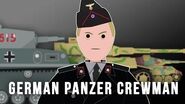The Panzertruppen uniform (literally; Armor troops uniform) or alternatively, Panzerwaffe uniform (Armored forces uniform) was a battledress of Nazi German (III Reich) origin. The term is firstly referred to well known and distinctive all-out black wool uniform of World War II German tankers, which was undoubtely their first and main recognition symbol through the entire war and which clearly differeted them from infantry in the first place and then also from all other branches of Wehrmacht.
However, it was designed and issued exclusively to crewmen of tanks (their famous Panzers), tank hunters (the Jagdpanzers) and armored cars (Leichte and Schwere or Puma), either belonging to Heer or Waffen SS units, but not to personnel of literally any combat vehicle. This was due to the fact that the crewmen of their tank destroyers (the Panzerjägers), assault guns (the Sturmgeschütz, Brummbär and Sturmtiger), self-propelled artillery (Bison, Wespe and Hummel) and anti-aircraft guns (Flakpanzer, Möbelwagen, Wirbelwind and Ostwind) formally wore standard Feldgrau (Field grey) panzertruppen uniforms, which were, by their design and insignia same as these black versions, but by appearance (pattern) roughly similar to the ones worn by the common Infanterie (infantry) units[1]. Also, the Feldgrau panzertruppen uniforms featured red edges on the collar and headwear (official color of Sturmgeschütz and Panzerjäger units), while these black Panzerwaffe versions always featured pink (bright red) colored edges.
The Panzertruppen uniform was firstly produced and issued back in 1934 and was always exclusively made out of wool, featuring completely black pattern, whose color, materials and even the sole design did not change until the very end of the war in 1945. However, the headwear and footwear with which the uniform was always paired occasionally changed through the time and course of the war.
Moreover, the original (black) uniform practically divided into two versions – the Heer (army) and the SS (paramilitary). Still, the only differences were not in the sole uniform (which was roughly the same in both cases) but only in insignia (collar patches and shoulder boards with rank epaulettes) worn on it, as well on its headwear (caps) and accessories (belts).
The Panzertruppen uniform is nowadays mostly known simply as the Panzer wrap or Panzer uniform. The originals (from World War II) are nowadays extremely rare and are mostly held in museum exhibits or eventually in hand of various collectors and are truly expensive, (depending on the condition though). Reproductions are naturally more often and easier to acquire, however, the more credibly and realistically made reproductions can also be very expensive and reach values almost as high as the originals from 1930 or 40s, which is mostly contributed to the fact that these uniforms are today still very rare and generally relatively hard to obtain (whether originals or reproductions) since they are not used nor serially produced for more than seventy years.
As much other pieces of WWII German uniforms and equipment, the Panzertruppen uniform is today also colloquially marked with popular Model-year designation, in this specific case; the M34 uniform (Model 1934 – by the year of its first appearance) which is, however, only an unofficial designation given nowadays by various collectors and WWII enthusiasts.
Heeres panzertruppen uniform[]
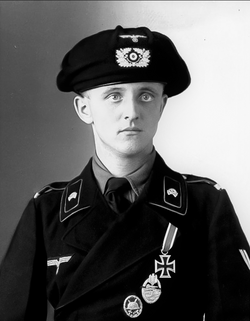
Original appearance of Heeres panzertruppen (from 1934 until 1940), wearing the panzertruppen uniform paired along with their distinctive, large panzertruppen barret (beret), which was later phased out in favor to classic peaked, side or field caps (see photos below).
As already mentioned, the first examples of Panzertruppen uniform were produced and issued to Heer (Army) tankers of the Wehrmacht back in 1934, (to be more precise, on 17th November that year) the same year when their first tanks (the light Panzer I and II) entered both serial production and service. The material was choosen to be the usual wool (also used in common Infantryman's Feldgrau) and the color was selected as black, while their insignia was chosen to be the traditional German death's heads (the Totenkopf) which were featured on square (cubical) background appearing as collar patches, enclosed with a pink (light red) edge, what was choosen as the official color of the Panzerwaffe (Armored forces). The same pink edge was also located on the edges of the collar itself, on the shoulder boards and another pink line was also located on some of the headwear components of the uniform.
In contrast to relatively common misconceptions of today - that this uniform and its death's head insignia were directly related to Nazism and Nazi ideology of death and hatred (which is especially present among less-informed viewers of these topics in general), in actual reality nor the black color of the Panzertruppen uniform nor the death's heads (Totenkopf) insignia had absolutely anything to do with Nasizm. In fact, both of these were taken from old Germanic traditions and famous as well as successful Black hussars (also known as the Schwarze legion, literally; Black legion) back from early 19th century (1805), which traditionally wore both death's head insignia on their headwear as well as black uniforms (about 120 years before the Nasizm showed its first traces at European scene).
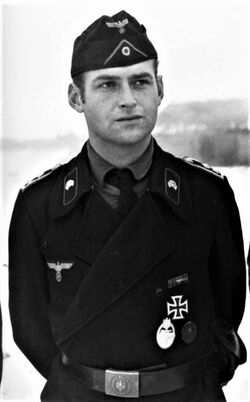
Unknown Heeres Hauptfeldwebel (Master/first segeant or Sergeant major) wearing the Heeres panzertruppen uniform paired with Heeres panzertruppen Schiffchen (used from 1940 until 1945) in winter of 1941 during Operation Barbarossa, Soviet Union. He is using the standard Wehrmacht leather belt with holster for side-arm, either Luger or Walther pistol.
So, the National Socialism, as the common right-wing ideology (by being conservative, traditional and mostly religious) actually greatly valued and respected the old German historical traditions and these Panzertruppen as well as Allgemeine SS service uniforms (which also used death's heads and featured black colors) were prime example of such, since these symbols and uniform color were not originally their inventions, but were taken directly from earlier historical periods.
Furthermore, the black color in case of the Panzertruppen uniform was selected for another even more important reason, since its dark appearance easily helped to conceal any spots of fuel, grease/lubricants, engine oil as well as gunpowder from fired shell cases, which is naturally expected to spoil the tanker's uniform at daily basis. Exactly due to same reason the Soviet Red army tankers (as German's opposing counterparts) wore exactly the same colored (black) one-piece coveralls in that period. Even more, the completely black two-piece suits were continuted to be used by all tankers of later Soviet army through most of the Cold war era – as far as 1980s.
The sole Panzertruppen uniform always consisted of four main components – the tunic/blouse, the pants/trousers, the boots (later shoes) and the headwear (originally beret, later replaced firstly with side, then with peaked and field caps). The buckling of both trousers and tunic was done exclusively by classic knobs. Tunic featured a two-piece collar (which firstly served for distinctive death's head collar patches) and shoulder boards (for attaching rank epaulettes). The distinctive cuff title featuring stylized letters of unit's name was occasionally worn on its lower left part of the sleeve (but mostly in SS case, though).
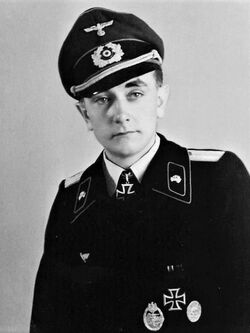
Heeres panzeroffizier, the Oberleutnant (Senior lieutenant) and tank ace Otto Carius from Schwere Panzerabteilung 502 (502nd heavy tank battalion) wearing the Heeres panzertruppen uniform paired along with Heeres Schirmmütze (used only by Panzeroffizieren from 1943 until 1945).
There was also a black genuine leather (calfskin) jacket as the additional piece, which was intended to be worn either directly above the tunic or instead of the tunic (above the shirt)[2]. It was essentially of the same design as the sole tunic and could also feature collar patches and shoulder boards featuring rank epaulettes. However, it was rarely used and worn out in the field, since the regular wool made tunic was found to be more than enough for most climates and seasons.
Originally, the Panzertruppen uniform was firstly issued with distinctive large black Panzertruppen barret (literally; Armored troops beret) featuring a German eagle and distinctive wreath decorated three-color (red, white and blue) roundel right below it. That kind of appearance was present in the first six years of its existence (1934-1940). After, it was later noticed that those berets were severly impractical as well as somewhat clumsy (especially during combat), because of which they were completely phased out and removed from usage by 1940 and replaced firstly with very popular side caps, often known as Schiffchen (meaning; Little boat, due to their appearance), which were used until the very end of the war (1940-1945).
Then, starting from 1943, the three new sets of headwear were introduced, firstly the well known Feldmütze (literally; Field cap) field cap, featuring foldable ear flaps which were buttoning via two visible knobs located on the forehead, and also two types of peaked caps - either Schirmmütze (Peaked cap) and Knautschmütze (Crushed cap). These field caps (Feldmützen) were formally intended only for Panzerkommandanten (tank commanders), while the two mentioned types of peaked caps (Schirmmützen and Knautschmützen) were intended exclusively for Offiziere (officers). So, the regular crewmen continuted to use the side caps (Schiffchen) until the very end of the war, as stated. In contrast to previous beret and later peaked caps, the side and field caps never featured the wreath decoration (as found in beret and peaked caps), but exclusively the solely eagle and roundel.
Interestingly, while the both Schiffchen and Feldmütze featured black (panzertruppe) versions, the Schirmmütze as well as Knautschmütze (which were also extensively used by panzertruppen, as mentioned) existed only in standard Feldgrau appearance (for both Heer and SS variants) and never featured any black (panzertruppe) versions.
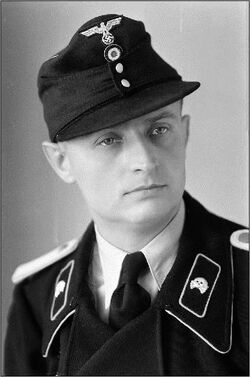
Unknown Heeres panzerkommandant wearing the Heeres panzertruppen uniform paired with Heeres panzertruppen Feldmütze, featuring button foldable ear flaps (used by panzerkommandanten from 1943 until 1945).
In context of the uniform accessories (like footwear and underwear), these also experienced changes during time and course of the war. Originally, the Panzertruppen uniform was issued with classic Wehrmacht Schaftstiefel (their distinctive leather jackboots), which were back then worn by almost all personnel and servicemen of the entire Wehrmacht. As in cases of other branches, these were officially used and worn for first nine years (from 1934 until 1943) when they were replaced with new, Schnürschuhe (literally; Lace shoes), also made out of genuine calfskin leather.
However, in case of Panzertruppen, these lace shoes were naturally not worn paired with distinctive double buckle Gamaschen (the gaiters) like in case of infantry, but were just worn solely with pants. This was due to purely logical fact, since vehicle crewmen are not expected to cross or walk through harsh terrain (such as mud, snow or water) like the common infantry.
In case of underwear, the Panzertruppen uniform featured an interesting and somewhat odd accessory, since it was normally worn with either a white (for officers) or greenish (for regular crewmen) shirt, paired with a black tie under the tunic, which was used even in combat. Only the tie was eventually left out in cases of individuals which were decorated with famous Ritterkreuz des Eisernen Kreuzes (Knight's cross of the Iron cross), which was then worn in its place (and those were actually many, which is exactly why the tie started to become a relatively rare sight as the war was progressing).
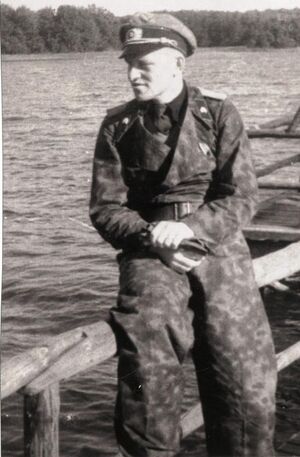
Unknown Heeres panzeroffizier wearing the improvised camouflage panzertruppen uniform, made from stripped pieces of SS Tarnjacke smock in Rauchtarn (Smoke pattern) paired with Heeres Knautschmütze (Crushed cap), used from 1943 until 1945 by Panzeroffizieren.
What is concern of other accessories, there were two types of leather belts intended for wearing tightened around the tunic. Firstly, the standard Wehrmacht's black leather belt (intended for literally all branches – from Heer to Luftwaffe and even Kriegsmarine) with square silver buckle featuring a German eagle enclosed by wreath with Wehrmacht's famous officiall moto Gott mit uns (God with us). In case of Panzertruppen, this belt was, naturally, always worn solely, that is, without the distinctive Y adjustable straps (the Hilfstrageriemen), since they did not carry near as much equipment on their belt as common infantrymen in order to need those to properly dispose balance and hold their belt in place.
Other type of belt was the brownish (sometimes also black) and the wider one, featuring sqaure but hollow buckle with double buckling, which was intended only for officers, in this case, for Offiziere der panzertruppen (Officers of the armor troops) or simply Panzeroffiziere (Armor officers).
In very rare cases, some of the Heeres panzertruppen personnel used the improvised (field-made) camouflage pattern uniforms, made out of stripped pieces of SS camouflage smocks (the Tarnjacke). These were made and worn mostly in cases were the standard black, wool-made uniform was unsuitable for some climates and seasons.
In case of weaponry and firearms, the Panzertruppen were originally issued exclusively with either a pistol (the well known Luger P-08 or Walther P-38) or eventually, with sub-machine guns (mostly MP-40 and rarely MP-41, MP-28 and MP-35) as the war progressed. They were not personally issued with any kind of hand grenades (the famous M-24 Stielhandgranate/stick grenade or less used, M-39 Eihandgranate/egg grenade). However, each tank was regularly issued with M-24 or M-39 metallic box containing either eight pieces of M-24 grenades[3] or thirty pieces of M-39 grenades[4], which were originally intended for vehicle defense against infantry in close quarters (urban areas), or for classic infantry combat if the tank was disabled or abandoned (in that case, they were carrying grenades on their belts, like the usual infantry). Panzertruppen were never issued with any other equipment (GM-38 gas mask, canteen and other), like the common infantry units.
Afrika korps panzertruppen uniform[]

Afrika Korps panzertruppen wearing the usual Afrika korps infanterie cotton made khaki colored tunics, with only classic infantry collar patches (the Litzenspiegel) replaced with Panzertruppen totenkopf (death's heads), as seen on the one to the right (wearing Schiffchen).
In case of Feldmarschall (Field Marshall) Erwin Rommel's Afrika korps (Africa corps), the Panzertruppen belonging to his unit naturally did not worn the usual black wool made uniforms, but instead simply used the one and the same infantryman's khaki or brownish made cotton Afrika korps uniform (tunic or shirt only), with only classic infantry collar patches (their distinctive Litzenspiegel) replaced with usual Panzertruppen Totenkopf (death's heads).
So, the exact Afrika korps panzertruppen uniform actually did not exist (theoretically, at least) but it was practically just the common infantryman's uniform worn with different (their own) collar and shoulder insignia.
SS panzertruppen uniform[]
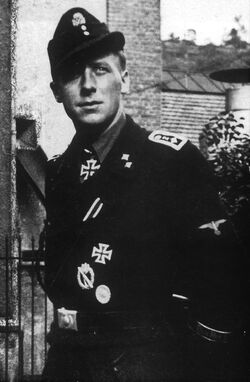
SS panzerkommandant, the Oberscharführer (Sergeant) and tank ace Ernst Barkmann belonging to Zweite SS panzerdivison Das Reich (2nd SS armored division), wearing the SS panzertruppen uniform paired with the SS panzertruppen Feldmütze (used from 1943 until 1945) and standard SS belt, during battle in Normandy in June 1944. The cuff title Das Reich can also be seen on his lower left sleeve.
As mentioned in the beginning, there was a verison of Panzertruppen uniform intended for crewmen of the Waffen SS, which was however, different only in insignia, shoulder boards as well as in collar patces, but not in the sole uniform (which was literally one and the same as in case of the original Heer variant).
The pants were roughly the same in both variants (since those did not feature any kind of symbols nor insignia), but the tunic in SS version featured their own shoulder boards and distinctive collar patches, which were neither the usual death's heads, nor were symmetrical (as in Heer version), since the left patch actually displayed the rank, while the right one displayed either the distinctive SS symbol (ᛋᛋ) or eventually the specific unit (SS division), which the carrier of the uniform belonged to.
Also, the SS version of the uniform was probably best distinguished in its headwear. Firstly, the SS version never came with beret as the usual Heer model (simply due to the fact that the first SS panzertruppen appeared yet in 1941 - at the time when these berets were already phased out of service).
Furthermore, the other three types of headwear (Schiffchen, Feldmütze and Schirmmütze or Knautschmmütze) which were also used and worn by SS panzertruppen, were easily distinguished from its Heer counterparts due to severely different insignia - the SS versions of these caps never featured distinctive three-tone wreath decorated roundel, but the characteristic SS Totenkopf (SS death's head) instead, which was sensibly larger than Heer's version and which was never worn on collar patches (as in Heer case) but exclusively on the headwear, as mentioned. Also, in case of SS panzertruppen, the Schiffchen side caps were officially also used and worn by offiziere (photo below), while in Heer case, they were formally worn only by regular crewmen (starting from 1943, since there was no other headwear type before then, so all Heeres panzertruppen were using exclusively Schiffchen).
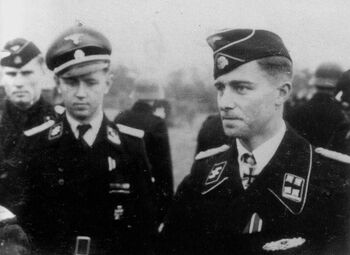
SS panzeroffizier, then Obersturmbannführer (lieutenant-colonel) Joachim Peiper from Erste SS panzerdivision Leibstandarte Adolf Hitler (1st SS armored division) wearing the SS panzertruppen uniform paired with SS panzertruppen Schiffchen (used from 1941 until 1945), during his unit rally at town of Rahden in Westphaila county (Germany, November 1944), where he greeted and decorated the veterans from battle of Normandy. At his right, the unknown SS Hauptsturmführer (Captain) is wearing the same uniform but paired with standard SS Schirmmütze (used from 1943 until 1945) and wider (officer's) belt with hollowed buckle.
So, due to the fact that both Heer and SS panzertruppen were actually using death's head insignia, many are nowadays often mixing them up (despite the fact that Heer panzertruppen wore them exclusively on their collar patches, while SS ones wore them only on the headwear, as mentioned). Also, one notable difference was the fact that SS panzertruppen wore their eagle crest on the upper part of their left sleeve, while their Heeres counterparts wore it frontally, on their right chest of the sole tunic.
In case of uniform accessories (boots, belts and underwear), the SS version also featured either the distinctive Schaftstiefel (Jackboots) or, during second half of the war, the classic Schnürschuhe (Lace shoes). They also featured the same two types of leather belts, the only difference being in the fact that SS belt naturally featured the SS version of the logo engraved on the same silver buckle. Their version featured a different eagle appearance and included their well known motto which read; Meine Ehre heißt Treue (My honor is loyalty) instead of previously mentioned Gott mit uns, as found in Heer variant. The other type of belt (the wider brown or black one featuring hollow buckle) was literally the same one used in Heer versions and was also used exclusively by the SS officers.
Same worth for the underwear, the SS version of the uniform also featured either a white (for officers) or greenish (for regular crewmen) cotton shirt along with a black tie to be worn directly under the black wool tunic. Tie was also left out only in cases of those which were decorated with the Knight's cross, since it was worn in its former place.
SS erbsentarn panzertruppen uniform[]
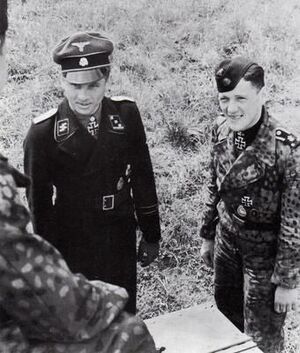
SS offizier and panzerkommandant, the Hauptsturmführer (Captain) and tank ace Michael Wittmann (left), also from Erste SS panzerdivision, taking a break with his crew beside his Tiger heavy tank during battle in Normandy, June 1944. All his crewmen (except himself) are wearing the distinctive SS panzertruppen Erbsentarn camouflage pattern uniform, including his gunner, the Oberscharführer (sergeant) Balthasar Woll (right).
Starting from 1944, the SS panzertruppen uniform had introduced almost completely different uniform model, which was a cotton made (instead of wool, as found in original black version) and which featured a new four-tone Erbsentarn (Pea dot pattern) camouflage pattern, which was introduced in the same year and naturally intended for infantry in the first place.
This was not introduced due to sole camouflage pattern (after all, the Panzertruppen wore the black color due to practical reasons) but purely due to standardization reasons and desire for lighter and more comfortable cotton material than the usual wool, a cotton in which only these camouflage patterns were produced.
Despite having exactly the same pattern as found in the regular infantryman's version, this SS Panzertruppen Erbsentarn uniform was actually roughly the same to the original black wool version by the sole design, due to featuring a tunic with same larger collar and with side buckling, what was not found in the infantryman's version of the Erbsentarn uniform (infantryman's Erbsentarn actually involved from then latest model of standard Infanterie Feldgrau uniform, difference being only in material and, of course, the sole pattern).
Somewhat ironical, the then newest Erbsentarn pattern was neverthless often issued to the Panzertruppe, despite the fact that it never managed to fully replace and phase out the previously used Tarnjacke (camouflage smocks) among infantry in the first place (there was always shortage of Erbsentarn uniforms among them, exactly due to which they were forced to combine the received Erbsentarn pieces with smock patterns or with older Feldgrau and other mis-matching uniforms until the very end of the war).

SS panzerkommandant, the Hauptsturmführer Karl Kloskowski, an ethnic Sudeten-German and member of Zweite SS panzerdivision Das Reich wearing the improvised camouflage tunic, made out of stripped pieces from infantryman's Tarnjacke in Eichenlaubtarn (Oak leaft pattern), during Operation Citadel (Battle of Kursk), 1943. He is also using the SS service belt (rounded buckle), which was very rarely paired with battledress, especially camouflage uniform.
However, this Erbsentarn version never actually replaced the original black wool version nor was it ever intended to replace it, but was actually intended exclusively for regular crewmen, while the Panzeroffizieren (Armor unit officers) and even the Panzerkommandanten (Tank commanders) kept their standard black, wool made uniform until the end of the war. So, starting from 1944, all SS panzertruppen personnel (except officers and tank commanders, as mentioned) officially and formally switched to the newly introduced Erbsentarn cotton made version of the uniform.
Additionally, decision to introduce the camouflage pattern (the Erbsentarn) among SS panzertruppen appeared after it was observed that even before the appearance of it, some of the personnel (mostly the ones located on the Eastern front), sometimes created their own improvised camouflage tunics, mostly in Eichenlaubtarn (Oak leaf pattern) pattern, which were made from stripped pieces of infantryman's Tarnjacke. Those were mostly made when the standard (wool-made, black) Panzertruppen uniform was too unsuitable for some climates and seasons (summertime, as well as hot steppes of southern Ukraine and Russia, as an example).
However, the only serially produced and officially issued camouflage Panzertruppen uniform was the one made in mentioned Erbsentarn pattern.
Gallery[]
Videos[]
The Panzertruppen uniform regularly appears in tons and dozens of World War II German footage of Panzerwaffe units, however, in these two choosen videos it is more closely observed:
In popular culture[]
|
Media |
Notes |
Date |
|---|---|---|
| Battle of the Bulge | Used by fictional German protagonist, the Oberst (Colonel) Martin Hessler and by all other Heeres panzertruppen, paired with Schiffchen | 1965 |
| Saving Private Ryan | Used by two Tiger I tank SS panzerkommandanten; the unknown Obersturmführer (Lieutenant) from the first Tiger (paired with Schiffchen) and the Sturmbannführer (Major) Hoess from the second one (paired with Schirmmützen and with Erbsentarn pants) | 1998 |
| Combat Mission: Beyond Overlod | Used by Heeres panzertruppen, paired with Feldmützen | 2000 |
| Combat Mission: Barbarossa to Berlin | Black version used by Heeres panzertruppen, improvised Eichenlaubtarn version used by SS panzertruppen, both paired with Feldmützen | 2002 |
| Call of Duty | Used by Heeres panzertruppen, paired with Schirmmützen | 2003 |
| Codename: Panzers | Used by fictional German campaign protagonist Hans von Gröbel (paired with Heeres Schirmmütze) and by Heeres panzertruppen (paired with Schiffchen) | 2004 |
| Soldiers: Heroes of World War II | Used by Michael Wittmann (paired with SS Schirmmütze) and by SS panzertruppen (paired with Schiffchen) | 2004 |
| Faces of War | Improvised Eichenlaubtarn version used by SS panzertruppen (paired with Feldmützen) and basic black version used by SS panzerkommandanten (paired with Schirmmützen) | 2006 |
| Men of War | Improvised Eichenlaubtarn version used by SS panzertruppen (paired with Feldmützen) and basic black version used by SS panzerkommandanten (paired with Schirmmützen) | 2009 |
| Combat Mission: Battle for Normandy | Used by Heeres panzertruppen (paired with Schiffchen) and by Panzerkommandanten (paired with Schirmmützen) | 2011 |
| Red Orchestra II: Heroes of Stalingrad | Used by Heeres panzertruppen, paired with Schiffchen | 2011 |
| Fury | Used by SS panzertruppen from Tiger 131; the panzerkommandant (Obersturmführer) wearing the basic black version paired with SS Feldmütze, while the rest of the crewmen are wearing the camouflage Erbsentarn version, paired with SS Schiffchen | 2014 |
References[]
- ↑ https://www.panzeraufgd.co.uk/images/stug/artillery-leutnant.jpg
- ↑ https://i.pinimg.com/474x/a0/c2/f9/a0c2f9253fbcf680c19a43d4a64a4448.jpg
- ↑ https://cdn.shopify.com/s/files/1/1524/1342/products/on3318__38.jpg?v=1571453959
- ↑ https://cdn.shopify.com/s/files/1/1524/1342/products/ONSV1012A__01.jpg?v=1571454288




